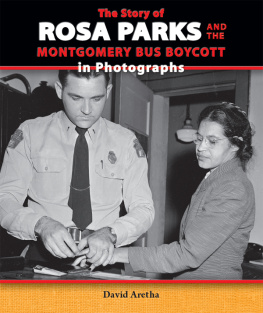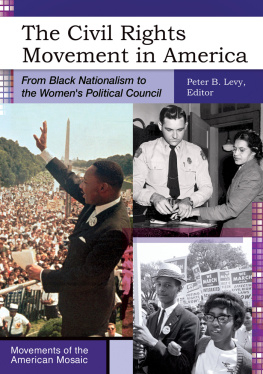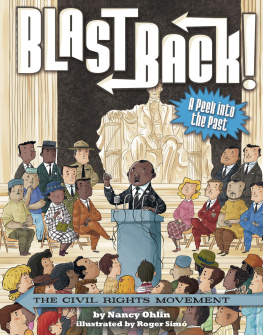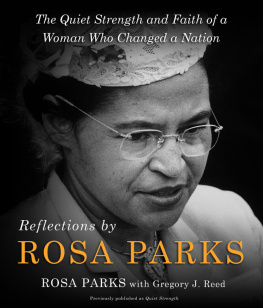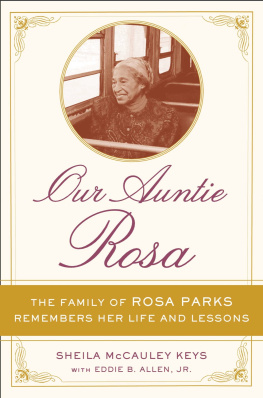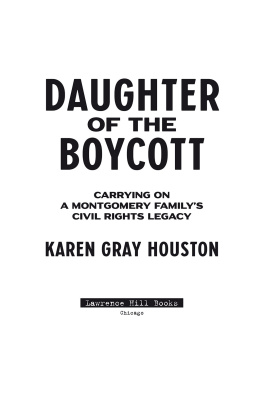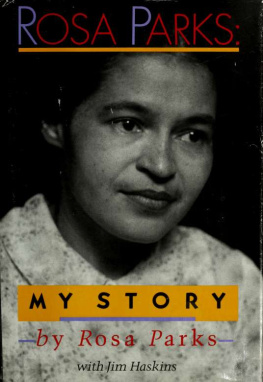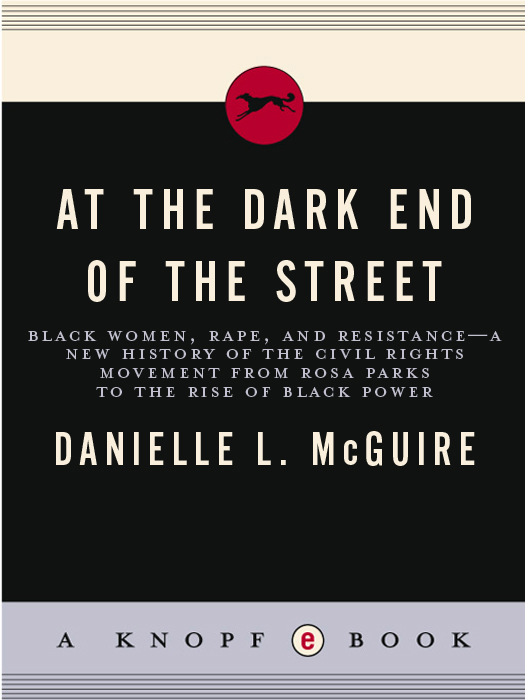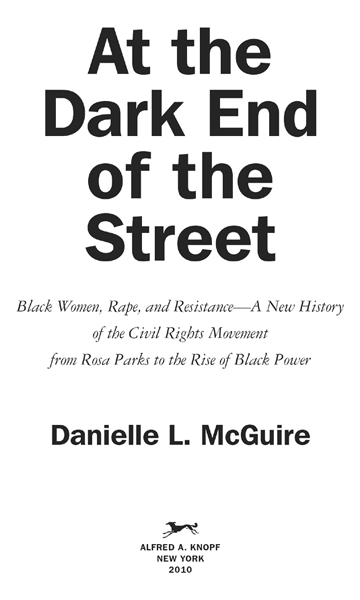THIS IS A BORZOI BOOK
PUBLISHED BY ALFRED A. KNOPF
Copyright 2010 by Danielle L. McGuire
All rights reserved. Published in the United States by Alfred A. Knopf, a division of Random House, Inc., New York, and in Canada by Random House of Canada Limited, Toronto.
www.aaknopf.com
Knopf, Borzoi Books, and the colophon are registered trademarks of Random House, Inc.
Library of Congress Cataloging-in-Publication Data
McGuire, Danielle L.
At the dark end of the street / by Danielle L. McGuire. 1st ed.
p. cm.
Borzoi Book.
eISBN: 978-0-307-59447-1
1. African-American womenCivil rightsAlabamaHistory20th century. 2. African-American womenViolence againstAlabamaHistory20th century. 3. RapePolitical aspectsSouthern StatesHistory20th century. 4. Civil rights movementsSouthern StatesHistory20th century. 5. Southern StatesRace relationsHistory20th century. I. Title.
E185.61.M4777 2010
323.11960730761dc22 2010012072
v3.1
For Recy and Ruby
Sex is the principle around which the whole structure of segregation is organized.
GUNNAR MYRDAL , 1944
Contents
Illustrations
Members of the SNYCs Third Conference Preparation Group gather at Miles College in Alabama, 1940. (Courtesy of the Moorland-Spingarn Research Center, Howard University)
Esther Cooper, executive secretary of the SNYC (Courtesy of the Moorland-Spingarn Research Center, Howard University)
Recy Taylor, Willie Guy Taylor, and their child, Joyce Lee Taylor (Courtesy of the Chicago Defender)
Rosa Parkss letter to Chauncey Sparks, governor of Alabama (Courtesy of the Alabama Department of Archives and History, Montgomery, Alabama)
Willie McGee ( Photo by Robert W. Kelley/Time & Life Pictures/Getty Images)
More than five hundred white men, women, and children gather outside the Jones County Courthouse in Ellisville, Mississippi, 1951. ( Photo by Robert W. Kelley/Time & Life Pictures/Getty Images)
Members of the Sojourners for Truth and Justicea national black womens organization dedicated to the protection of Negro Womanhoodwith Paul Robeson in 1952. (Louise Thompson Patterson Papers, Manuscript, Archives, and Rare Book Library, Emory University)
Rosa Lee Ingram with sons Sammie and Wallace in an Albany, Georgia, jail cell, 1948 ( AP/Wide World)
Rosa Parks and Frederick Douglass Patterson at Highlander Folk School in July 1955 (Courtesy of Wisconsin Historical Society, 56309)
Boycotters, February 1956 ( Photo by Don Cravens/Time & Life Pictures/Getty Images)
Three police officers watch a group of African-American women waiting at a carpool pickup location. ( Photo by Don Cravens/Time & Life Pictures/Getty Images)
African-American women filled the pews at weekly mass meetings. ( Photo by Grey Villet/Time & Life Pictures/Getty Images)
Armed white men attack two black women after a desegregation attempt in Montgomery, Alabama. ( Photo by Charles Moore/Blackstar)
Mrs. A. W. West (Courtesy of the Montgomery County Archives)
Jo Ann Robinson (Courtesy of the Montgomery County Archives)
Euretta Adair (Courtesy of the Montgomery County Archives)
E. D. Nixon (Courtesy of the Montgomery County Archives)
Reverend Solomon Seay, Sr. (Courtesy of the Montgomery County Archives)
Reverend Ralph Abernathy (Courtesy of the Montgomery County Archives)
Reverend E. N. French (Courtesy of the Montgomery County Archives)
Reverend Martin Luther King, Jr. (Courtesy of the Montgomery County Archives)
Fred Gray (Courtesy of the Montgomery County Archives)
African Americans gather outside the courthouse as Reverend Martin Luther King, Jr., stands trial for conspiracy. ( Photo by Don Cravens/Time & Life Pictures/Getty Images)
Rosa Parks speaks with an interviewer as she arrives at court with E. D. Nixon and others on trial for violating a 1921 antiboycott law. ( Bettman/Corbis)
The Fellowship of Reconciliation comic book, published circa 1957, gave rise to the myth of Rosa Parkss tired feet and Martin Luther King, Jr.s, heroic leadership of the Montgomery bus boycott. (Courtesy of the Fellowship of Reconciliation and the Ed King Collection of Civil Rights Material, Archives Center, National Museum of American History, Smithsonian Institution)
Melba Patillo (Courtesy of the Wisconsin Historical Society, 52734)
Police investigate a Ku Klux Klan cross left on the front lawn of L. C. and Daisy Bates in October 1956. (Courtesy of the Wisconsin Historical Society, 52745)
Alabama state senator Samuel Engelhardt, Jr., promotes a white only anti-integration rally. ( Photo by Don Cravens/Time & Life Pictures/Getty Images)
Scene of the crime where four white men from Tallahassee, Florida, kidnapped and raped an African-American college student ( Photo by Grey Villet//Time Life Pictures/Getty Images)
Joe D. Cooke, Jr., an intern from Florida State University, defied racial conventions when he agreed to search for the white assailants of an African-American college student. ( Photo by Grey Villet//Time Life Pictures/Getty Images)
On May 4, 1959, more than one thousand Florida A&M University students gathered on the universitys quadrangle to demand justice for Betty Jean Owens. (Courtesy of The FAMUAN, the Florida A&M University student newspaper, May 1959)
Patrick Scarborough, David Beagles, Ollie Stoutamire, and Ted Collinsworth ( Photo by Grey Villet//Time Life Pictures/Getty Images)
State prosecutor William Hopkins ( Photo by Grey Villet//Time Life Pictures/Getty Images)
Judge W. May Walker ( Photo by Grey Villet//Time Life Pictures/Getty Images)
await the verdict of four white men accused of raping Betty Jean Owens, a black college student. ( Photo by Grey Villet//Time Life Pictures/Getty Images)
Cartoon featured in an African-American newspaper, May 16, 1959 (Courtesy of the Baltimore Afro-American)
African-American women made up the bulk of the 257 Florida A&M University students arrested for protesting segregated movie theaters in Tallahassee in the spring of 1963. (Courtesy of the State Archives of Florida)
Fannie Lou Hamer (Will D. Campbell Papers, McCain Library and Archives, University of Southern Mississippi)
Two trustees carry an African-American woman to the paddy wagon in Jackson, Mississippi, 1963. (Courtesy of the Library of Congress)
Police crammed a group of teenage girls into a stockade in Leesburg, Georgia, after they were arrested for protesting segregation at a movie theater. ( Photo by Danny Lyon/Magnum Photos)
Endesha Ida Mae Holland with SNCC voting-rights activists ( 1978 Matt Heron/Take Stock Photos)
Allen Thompson, mayor of Jackson, Mississippi, with police force and armored tank as the city prepares for the arrival of black and white voting-rights volunteers in the summer of 1964 ( 1978 Matt Heron/Take Stock Photos)
Dallas County sheriff Jim Clark (Courtesy of the Library of Congress)
Jim Clark ordered hundreds of schoolchildren arrested after they held a silent demonstration outside the Dallas County Courthouse on February 3, 1965. ( Corbis/Bettman)
An Alabama state trooper accosts Annie Cooper, an African-American woman, as members of Jim Clarks mounted posse rally in the background. ( Corbis/Bettman)
Viola Liuzzo ( AP/Wide World)
An Alabama state troopers car is parked near the site where the Ku Klux Klan fatally shot Viola Liuzzo and injured Leroy Moton. ( AP/Wide World)



